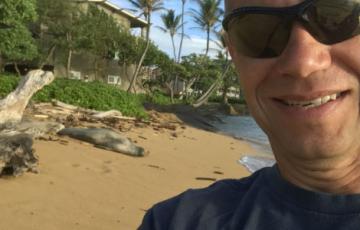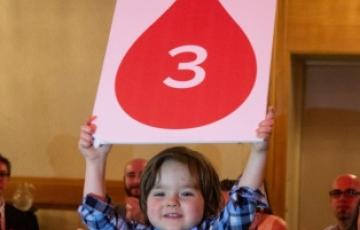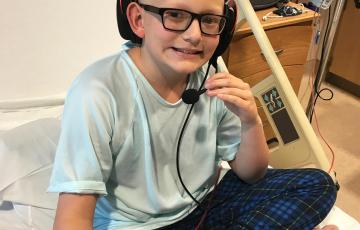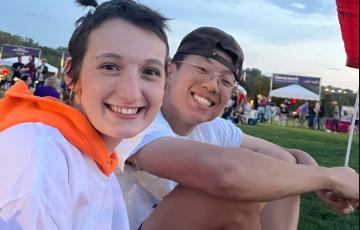Search Results
Ron
Ron was a private man. He didn’t seek the company of many. But the friends he had were close, and more than anything, he cherished his time the most with his loving wife and best friend, Paulette. The two of them shared a love for fishing and traveling. They traveled all across the western United States searching for the best fishing spots. They even had a place in Baja California where they spent most of their time fishing together. Ron was unapologetically himself, and he never once cared about what others thought of him.
Riley
On March 28, 2018, my husband brought Riley, my sweet, spunky six-year-old, to the emergency room for unbearable leg and hip pain, so unbearable she could no longer walk. I had a baby at home who wouldn’t take a bottle, so I had to let Tim, her dad, take her in without me. We were expecting to hear that she had a bone fracture or maybe even that something was broken.
We were not prepared to hear that she had cancer.
Every single day more than 40 parents will hear those exact same words, “Your child has cancer.”

Jason
I'm Jason, and I am 38 years old. Early last year I was very sick. I had a fever that would not go away for over three months. Every day I broke 103 degrees, and at least six times I hit 106 degrees. I was getting bloodwork after bloodwork done, seeing doctor after doctor when finally, I met my oncologist, and he did a bone marrow biopsy. He called me the next week and told me I had stage 4 Hodgkin lymphoma (HL), and we needed to start tests immediately so we could expedite my chemo treatment.

Jerome
Most importantly, the doctors, nurses, and researchers are true angles; wouldn’t be here without them. Dedicating their lives to saving others’, I am forever thankful. Not to mention the secretaries, volunteers, and administrators who are the lubrication to the operation, thank God.
It has been a while, but here’s the summary: Diagnosed with ALL in Oct. of 1986, remission shortly after in Dec. of 1986, then 2.5 years of chemotherapy and a few weeks of radiation therapy. It all changed my life... for the better.

Stanley
Stanley was only 13 months old when he was diagnosed. He was a happy and healthy baby boy. Showing no previous symptoms or signs of sickness, Stanley was rushed to the ER one late Wednesday night because his parents, Joe and Krissi, thought he might have swallowed something. That was December 16, 2015. By 8p.m.

Nikolas
Hello, my name is Nikolas Davison. I am 14 years old (almost 15 in July) and have battled acute lymphoblastic leukemia (ALL) for the past four years, but I am now done with chemo and getting my port removed soon.
In November 2016, I was misdiagnosed with appendicitis and was taken to the hospital by my father, where they took my blood and ran several tests. This was a painful experience to go through and I was very scared. After more tests, they knew that I had cancer. I was shocked, scared and horrified. I never thought in a million years that I would get cancer.

Alessandra
At the age of 14 I was diagnosed with stage 4 Hodgkin lymphoma. The doctors only gave me a 25 percent chance to live. I still remember the day I walked into the ER with my mom to get my CT scan done. Post exam, the doctor muttered,“You have cancer, but don’t worry just yet. The test tomorrow will let us know more.” Before I knew it, the next day, I found myself staring at the operating room ceiling, numb to the thought that it was all too real. Hours of surgery later, we found out the cancer had spread through my neck, entire chest and lungs.
Leimomi
I was diagnosed with non-Hodgkin’s lymphoma in 1998 at the age of 38. My participation in a clinical trial included a stem cell transplant, five chemotherapy sessions, and full-body radiation treatments. I am an advocate for participation in clinical trials, which paves the way for new treatments or prevention methods. Although it was a rough experience, the responsibility of being a single mom kept me going. My inspiration for surviving was my son Brian who was 12 years old at the time. He was born with microcephaly (small brain) which made him totally dependent for all his needs.

Nicolas
My name is Nicolas and I am 14 years old. Before my diagnosis I was a completely healthy child, in fact I was rarely ever sick. I played baseball, had straight A’s, and recently had recently got a new puppy. This sense of normalcy came to a screeching halt on January 13, 2018. That’s the day I was admitted into the pediatric ICU and the day I first heard the words, “you have cancer.” My family and I were devastated.

Linda
In July of 2009, I was diagnosed with small lymphocytic lymphoma (SLL) after a biopsy of the lymph nodes in my neck. Of course, I did what everyone says not to do. I went online to read about it. I read there was no cure, and the average lifespan after diagnosis was 10 years. I was 57 at the time, and all I could think was that’s not long enough. I don’t even have grandchildren yet!

Katie
Only a couple weeks into my first year of my graduate program, I was diagnosed with acute myeloid leukemia (AML) with FLT3 mutation. I was only 21 years old and my entire world got flipped upside down. My whole life changed and I was about 1,000 miles from home.
Fertility and Pregnancy
Fertility, Pregnancy and TKIsPatients of childbearing age, as well as the parents of children with cancer, should ask their healthcare team to explain how treatment may affect fertility (the ability to have children). Patients with CML who will be taking TKIs should discuss fertility preservation with their doctors before starting TKI therapy.
Growing numbers of CML patients of childbearing age are living in stable remissions and are considering having children while being treated for CML. There is no risk that parents will pass the Ph chromosome onto their children.
Diagnosis
Diagnosing chronic myelomonocytic leukemia (CMML) usually involves a series of repeated tests, including blood and bone marrow tests. Your doctor usually can't confirm a diagnosis of CMML with one lab test result that shows abnormal blood counts. Instead, he or she will monitor you over a period of time with repeated lab tests that show abnormal blood counts. This is done to rule out other diagnoses.
Bone marrow testing involves two steps usually done at the same time in a doctor's office or a hospital:
Treatment
It's important that your doctor is experienced in treating patients with myeloma or works in consultation with a myeloma specialist. This type of specialist is usually called a hematologist oncologist.
Types of Treatment for MyelomaYour treatment may include one or more of the following therapies:
The International Prognostic Scoring System
Specific factors may affect the prognosis (likely outcome) of MDS, and help doctors determine when to start treatment and how intensive the treatment should be. These factors include:
Your Treatment Team
Oncologists and hematologists are specialists who treat persons with leukemia, lymphoma, myeloma, myelodysplastic syndromes and myeloproliferative diseases. Pediatric hematologist oncologists treat children, adolescents and some young adults who have blood cancers. The oncologist or hematologist-oncologist coordinates a treatment and follow-up plan that involves other doctors as well as nurses, social workers, case managers and nutritionists.
Talking with Family, Friends and Children
Many people find it best to be honest with family and friends. By confiding in loved ones, you give them the chance to offer their support. It's true that some of your relatives or friends may not know what to say or do. But most do want to be supportive.
Consider "appointing" a willing family member or friend to be your "press secretary." He or she can be responsible for regularly letting others know your health status so you can focus on your treatment and recovery.
Possible Treatment Effects
Possible effects on spermSperm is made and stored in the testes. Sperm production begins at the onset of puberty and continues throughout the person’s life, although the amount and quality of sperm can naturally decrease with age. Cancer treatment can cause:
Fertility
People in the YA age group can be in many different stages of life. You may have children; you may want children in the future; you may not want children now, but may change your mind; or you may not have given it much thought at all. Cancer treatment can affect fertility in both women and men making it difficult to conceive a child in the future. A cancer diagnosis may require you to think seriously about children.
Not all cancer treatments affect fertility. Your risk depends on several factors, including
Childhood Blood Cancer
Hearing that your child has cancer is terrifying. Today, however, most childhood blood cancer patients can expect to have full and productive lives. Thanks to new and improved therapies, survival rates for childhood blood cancer have improved significantly over the past several decades. In addition, doctors, nurses and researchers continue to search for the causes of childhood leukemia and lymphoma to develop even better treatments and tailor therapies to decrease toxic side effects.
Targeted Therapy
Targeted therapy is a type of treatment that uses drugs or other substances to identify and attack specific types of cancer cells with less harm to normal cells. Not all cancers have the same targets. Each type of targeted therapy works a little bit differently, but they all interfere with the growth and survival of cancer cells. To find the most effective treatment, your doctor may run tests to identify the genes, proteins and other factors in your cancer cells. This helps the doctor choose the most effective treatment for you based on the specific factors of your disease.
Disease Complications
In medicine, a complication is a medical problem that occurs during the course of a disease or after a procedure or treatment. Possible complications of PV include:
Don
Like so many individuals diagnosed with blood cancer, I had zero thought that I might be ill, much less with a disease that could take my life.
I had signs and symptoms that something wasn’t quite right in my body, annoying things like shortness of breath, lightheadedness, and fatigue. However, nothing registered in my head until after my diagnosis.
It’s September 2005, and I am pretty much invincible, bulletproof! I could, in fact, leap tall buildings in a single bound! Yes, in my mind I was Superman!

Rachel
My name is Rachel Iruegas, and on June 4, 2019, I heard the dreaded words that no one ever wants to hear: “you have cancer.” I was diagnosed with stage 2B Hodgkin lymphoma (HL). In that moment, my mind went blank and my body numb. I honestly do not remember much of what my oncologist said after that. I knew I was in the room with her, surrounded by my family, but my body wanted to be somewhere else – anywhere else but there. I knew in that moment that my life was going to completely change, and I had no way of stopping that.
Adam
My wife left me after 33½ years of marriage (37½ including dating) and 2½ years into my remission. I read stories about a spouse, usually a male for some reason, who up and left his partner either during active treatment or when everything looked like the patient, the person, would live, but I never thought any of that would happen to me, and it sure as heck did. She fell out of love with me, with caring for me, with helping me. I may have been an ass, but I wasn't an asshole ― you know what I mean? She probably feels she didn't deserve any of this either, but . . .